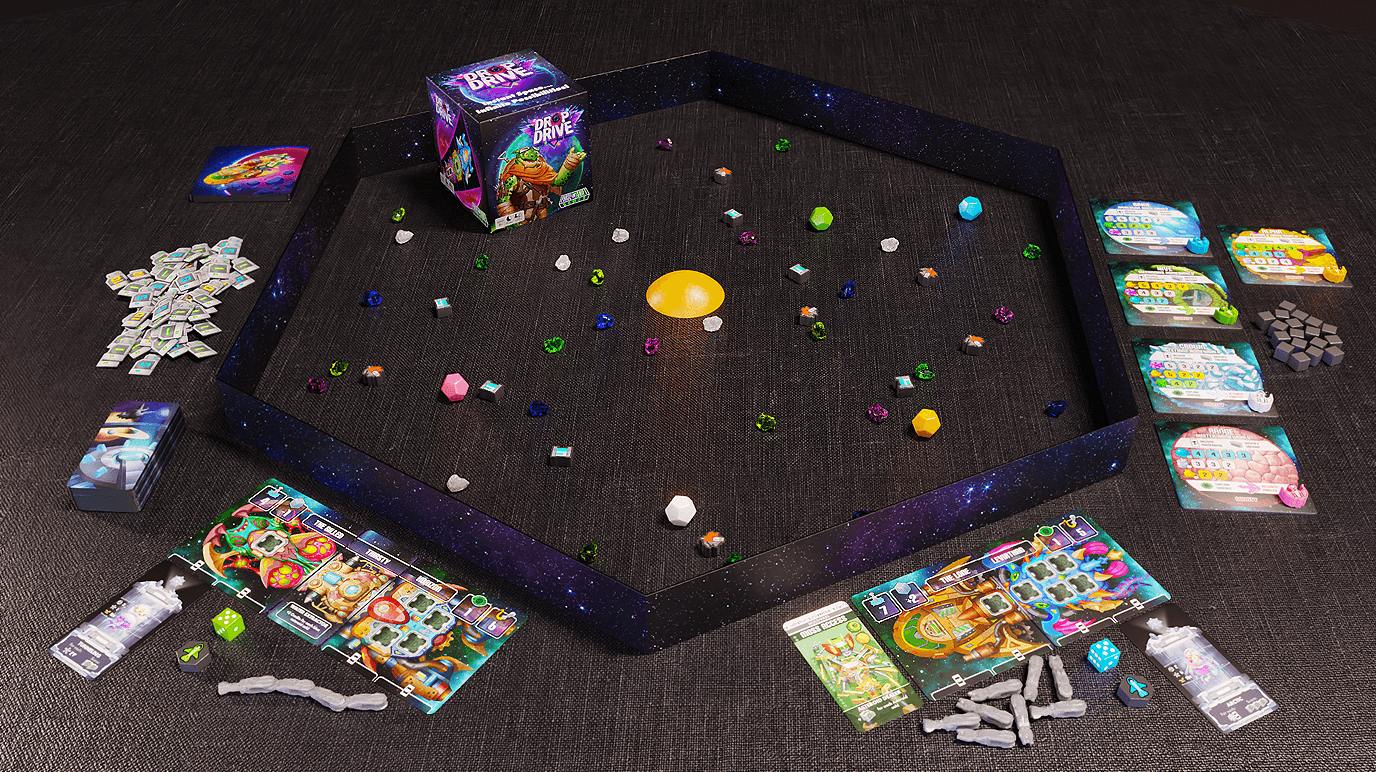Mine Resources and Explore Planets in Drop Drive

The latest in the Drop series from Scott R. Smith and Phase Shift Games, Drop Drive places players in the captain's chair to secure the most credits for completing various tasks in this 20-30 minute pick-up-and-deliver game.
Gameplay
Drop Drive is for 1-4 space entrepreneurs. Set up begins with each player taking the respective color ship and die. Ship fronts and ship ends are dealt, with one of each going to a player. These contain data for drop height and travel distance in the playing area, as well as available cargo space for collecting the various flotsam and jetsam of space for credits. Players are dealt three Explorer cards, choosing two and discarding one. Explorer cards provide passengers to be dropped off at one of the five planets for a bonus, additions to spaceships that provide additional storage or benefits, or cards that provide additional credits at the end of the game for scoring.
The playing area is cordoned off with walls, forming a hexagon. The bright, orange sun will be positioned in the middle, with the bag of goodies and planet bits being dropped from a predetermined height over the star. Any pieces that are stuck to the sides of the walls or the sun or that bounce outside the play area are gathered and dropped again. The five planet cards with the associated pirate ships are set beside this makeshift solar system, and explain the actions players will take when visiting them.
Players will take turns dropping their spaceship into this chaotic solar system, the height determined by the drop height outlined on their ship front. This is measured out by a unique Nav Tool, which is an expandable portion of plastic with each piece representing one length. After a player chooses where to drop their ship, they will use the Nav Tool to measure the length of movement they can take, which is noted on the ship back’s card, collecting any salvage, fuel containers, and asteroids in the path.
When players visit a planet, they will sell off the corresponding asteroids for credits and use a marker to show that the value has been used. These markers are used to signify the end of the game, and the number used in a game is dependent on player count. When a planet is visited players will also draw a number of Explorer cards indicated on their ship back card, keeping one and discarding the rest. The corresponding pirate ship on the planet is also dropped into the solar system. Pirate ships will steal the nearest asteroid of its same color. If other pirate ships are out in the solar system, they will be activated during this phase as well. Players who encounter pirate ships during their movement can battle them by rolling their dice and using the modifier on the ship front card that specifies their battle rating. If a player rolls higher, they will claim any asteroids the pirate has claimed on their planet. If a player loses, the pirate ship is picked up and dropped again back into the solar system.
Play continues until all the markers in a game have been used. Players make one last emergency stop on the nearest planet, selling off asteroids, gaining Explorer cards, and dropping off passengers (if possible). Credits earned throughout the game are totaled with any end-game scoring from Specimen gained from Explorer cards and the highest total is the greatest space explorer.

Image provided by the publisher
Review
Despite the initial hurdle of understanding all the actions one can take when first playing, Drop Drive is a fantastically simple-to-learn game that allows players to jump in and blast off. The mechanics are easy to discern through an ever-changing solar system. There is plenty of variety in the Explorer and ship cards, allowing each game to provide a slightly different strategy despite the fall of the bits and the available movement points.
However, some are going to be upset by some of the tools needed to enjoy the game. Drop Drive comes in a compact box, making it easy to store...until you factor in the walls needed to form the hexagon of the solar system. Granted, these are optional and not necessary for enjoying the game — but without some barrier, the pieces dropped into the solar system will go far away and make traveling to them unruly. Players need a compact solar system to truly reap the benefits, especially if their movement is limited.
This doesn’t take away from the overall fun and compactibility of Drop Drive. That it’s easy to pull off the shelf and play with kids as young as 8 years old and adults, but has variability and additional challenges in how the game can scale difficulty-wise, should not be ignored. Even in prototype form, the plastic pieces are sturdy and durable and the cardboard and card stock are thick, meaning it will withstand the wear and tear a game of this sort will inevitably endure.
There is nothing fancy or complex involved in Drop Drive’s mechanics but there doesn’t need to be. Keeping the game’s main actions easy to do and play moving rapidly allows games to fly by. But there’s enough within its core package to make it something more than just a filler.
Phase Shift has taken its Drop series (also featuring Dungeon Drop) and has turned it into a viable platform, not just a gimmick. While it’s easy to ponder what will be next from Phase Shift and Scott R. Smith in this line of games, right now it’s easy to enjoy what is the best evolution of the series to date.
Drop Drive is currently on Kickstarter.
Pros: Compact packaging, durable components, fun & enjoyable mechanics
Cons: Hexagonal walls hard to store but necessary to prevent sprawl




